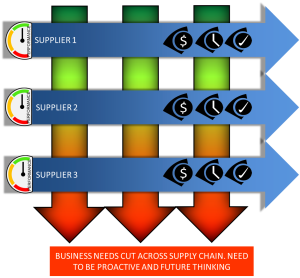Supplier Management is a tricky business; you often have a complex array of commodities or services being provided by an selection of different companies.
And just to make life just that little bit more difficult, it’s rare that each supplier acts in isolation. More often than not a part of what one supplier delivers (or not!) will directly impact a part of what another supplier delivers and the knock-on goes down the chain.
In a service delivery environment these impacts or difficulties can be exaggerated because any process in place won’t follow a nice linear manufacturer line but has the variable of a customer and choice to accommodate.
What works well – managing by commodity
What we have seen in a diverse service related supply chain is that Subject Matter Experts (SMEs) control the suppliers and therefore the commodity in isolation. There is a lot of sense behind this as the SME understands;
- The market place
- The commodity
- What good looks like
The end result is often that each supplier or commodity is generally well managed and the three key pillars of measurement (cost, time and quality) are where they need to be or within an acceptable tolerance. The “horizontal” management which is most common place certainly has merit.

What does not work quite so well – the wider view
However, the business in which the supply chain fits is rarely run on commodity lines; there is a wider strategy, vision and set of goals which the supply chain will contribute towards.
Let’s take a theoretical example. The board of your company has received consistent feedback that whilst their offering is considered to be at a good price point, customer complaints are escalating and the service rating has never been lower. Strategic change has been required therefore to improve quality across all areas and it is accepted that this might have a small cost increase. Because the business has been slow to effect change in the past, there is now a big pressure push from the top to see action.
As Head of Supplier Management you gather your team to explain the revised focus.
- You review the complete supply chain metrics looking specifically at the service performance
- Each supplier has been consistently outside target, but only by a relatively small margin
- In isolation and viewed in a silo of single supplier activity this service drift was noted but not deemed worthy of a bigger set of actions
- As a combination though, the service failure looms a lot larger
Next actions look something like this
- Each SME is now tasked on service over cost
- Each will pull a set of meetings to relay this to each supplier they deal with
- Each will tell you why something can be done but maybe not as you outlined because of “unique conditions to my commodity”
- Some will increase prices and ask for a service improvement with very marginal improvements
And so on, and so on.
How to include a wider and future focussed perspective
So in addition to managing by commodity it is as important to view the complete supply chain output through the same measures and lens as that of the wider business.
Also it’s worth thinking more about HOW the supply chain is measured.
Performance targets and Management Information (MI) are vital barometers of how the supply chain is or was fairing; with as long as a month’s delay in receiving MI it is often a snapshot of the past. By reviewing the supply chain output as a future focussed risk assessment proactive measures or at least plans of actions can be formed at a far earlier stage.
Any templates that could do this for me?
Are there any templates that can do this for me?
This Supplier Dashboard and Log does a great job – it is tried and tested!